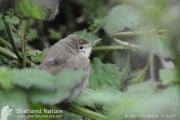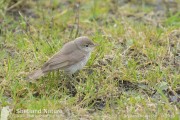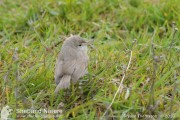Sykes’s Warbler – Shetland’s third of the year
Posted by Brydon Thomason on Wednesday 6th October 2010 | Birding in Shetland
On the morning of the 6th October James McCallum (who had stayed the night with myself and family) headed out before me, leaving me to get our 11 month old son Casey ‘up and about’ for the morning. He had literally been gone two minutes when my mobile rang, “I’ve got a Booted or a Sykes’s in front of your parents’ house”. I could see him standing by our agricultural sheds, literally a stone’s throw from the kitchen window! Before I had even hung up the phone my bins, jacket and Muck boots were donned as I left my wife Vaila with our son.
At this point James had quite literally only had a couple of very brief views of the bird. Only days before he had alerted Roger Riddington (a fellow Shetland Nature leader) to check out the Channerwick ‘Booted’ as in his mind it appeared far from a typical Booted warbler. That bird was actually then re-identified by Roger as a Sykes’s warbler, despite having been present for several days and watched by many birders, including tour groups who all ‘ticked it off’ as a Booted.
Knowing this, and by the expression on James’s face as I joined him to relocate it, I had the feeling it was going to be a much rarer bird than Booted warbler…
It took a few minutes to relocate the bird. It was quite mobile at first, often dipping down amongst the lush docking leaves in the area it seemed to favour, where it found shelter from the strengthening breeze blowing from the south west.
During the course of our observations the bird eventually began to settle as it no doubt started to familiarise itself with its rather unfamiliar surroundings. Being in the fortunate position of us both having very recent experience of Sykes’s (for me Rory and Will’s bird in August) the identification was quite straight forward and eliminating other potential ‘hippo’s’ was not a concern.
Between us we set about evaluating the features the bird showed or indeed didn’t show. The following were among the main conclusive features;
- Structurally the bird’s long-billed and long-tailed appearance was immediately obvious.
- Its ‘jizz’ and posture were also good; typically Sykes’s hold a ‘banana’ shaped profile with the long tail held above the horizontal and the wings dropped either side (a stance also typical of Blyth’s reed). This profile is slightly exaggerated with the longish bill and long sloping fore-crown.
- The tertials were very pallid and plain, showing no contrast at all. Like Blyth’s reed warbler they were totally concolourous with the rest of the upperparts as opposed to the slightly contrasting centres shown in Booted warbler. The fringing of the flight feathers did however show slightly warmer and faintly richer tones at time. This feature (along with all the others noted) were also quite distinct on Rory and Will’s bird on Unst in August).
- The lores were completely unmarked and comparatively quite long (with the ’beedy’ eyes appearing to be set slightly back) which created a distinctly ‘open- faced’ and rather blank looking facial pattern and overall ‘soft’ expression. This impression was probably further exaggerated by the distinct, bold and well defined supercilium which stopped just above the eye, merging into a clean and quite distinct eye ring. The sub-coronal/lateral crown stripe (border above the ‘super’) was almost lacking and only at certain angles could you see a hint of one, unlike Booted which is often more pronounced.
- The bare parts too were important features, with the legs and feet being a fairly pale grey with a slight bluish tinge. Booted warbler having paler fleshy coloured legs with darker feet (hence the name ‘Booted warbler’).
- Like the Unst bird in August, this one often called, giving a soft, short, dry and rather acrocephalus like ‘chck’, distinctly different from that of a Booted warbler.
By the time the first birders arrived (amongst them our ‘Autumn birding’ tour group led by Martin Garner- their second Sykes’s of the week!) the Sykes’s had become very obliging, giving views down to a few metres.
Incredibly this bird represented the third Shetland and fourth British record of the year. Prior to this year’s birds there had been only a dozen records in Britain, half of which are from Shetland.
For me personally it was a real thrill being in on this bird, having found one on Unst back in 2003 (the 6th British record), it being a first for Fetlar and, most importantly, a garden tick for the list I still keep at my parents’ house!




